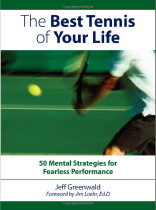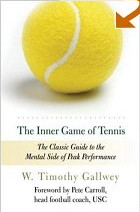November 3, 2001 Article Latest Between The Lines Article Between The Lines Archives:
Tennis Server
|

 |
Several happenings make the late-year season in pro tennis less interesting than in other years. The absence of the U.S. team from the eight-team Fed Cup finals in Madrid clearly blemishes the stature of that event, though the competition among the remaining nations should be lively. The ankle injury to Martina Hingis and the absence of Venus Williams have diminished the indoor tournaments in Europe and the closing stages of the WTA points race. Meanwhile on the men's side, the year-end doubles championship in Bangalore has been cancelled. A robust Davis Cup final is expected in Australia, however, while the verdict deciding the year's points champion yet depends on the final two events, in Paris and Sydney. THE MEN'S RACE For six years in a row, 1993-1998, Pete Sampras finished atop the official rankings. Pete's superb run ended in Agassi's big year, 1999, when Andre led the race comfortably from the outset. Then last year, matters awaited the final weekend of the Master's Cup, held in Lisbon, where the four semi-finalists were, intriguingly, the year's four Slam-winners. Kuerten in Lisbon in turn defeated Sampras and Agassi to win the event and the year's points race. Again this year, no player captured more than one Slam. Agassi took the early lead by winning first the Australian Open in January, then Indian Wells and the Ericsson. During the spring Gustavo Kuerten's excellent clay-court results, including his triumph at Roland Garros, lifted the Brazilian star also out of the pack. Ivanisevic won Wimbledon but won no other events during the year. Meanwhile Lleyton Hewitt scored well in many events and in September captured the U.S. Open, rising to third place in the point standings. He then won the Japan Open in early October. Yet ahead was the indoor circuit in Europe, including the Master's Series tournaments at Stuttgart and Paris, followed by the year-ending Master's Cup, scheduled this year in Sydney. Three players, all winners of Slams, were well ahead in the points race as of October 14:
Kuerten, 755 At Stuttgart the following week, Hewitt reached the semis, thus moving past Agassi into second place. Both Kuerten and Agassi lost their opening matches. Then Kuerten, clearly slumping, lost his first match at the Swiss indoors, while neither Agassi, now wed, nor Hewitt competed. Here were the standings on October 28, with Paris and Sydney still to come.
Kuerten, 757 Pat Rafter was a distant fourth in the standings, closely followed by Ferrero and Kafelnikov. Each of these needed to capture both Paris and Sydney to have the slightest chance of overtaking Kuerten. Rafter, who did not enter in Paris, was thus already out of contention. The Paris indoors is in progress as this column is being written. The winner will earn 100 points. Kuerten and Hewitt are both competing, at opposite ends of the draw, while Agassi is not playing. A Kuerten triumph would eliminate Agassi's chances for the top spot. But whatever happens in Paris, the final verdict will not be known until Sydney, November 12-18. Each win in the round-robin phase, where each entrant plays three matches, will yield 20 points. The winning semi-finalists will bank an additional 40, and the final winner will add an additional 50. Thus a player can win a maximum of 150 points. IS THE POINT SYSTEM FLAWED? Decades ago, the rankings of the top stars were made subjectively, by evaluating Slam and other tournament results, meanwhile giving emphasis to head-to-head results. Writers and fans hashed over the year-end official rankings. Dissenting opinions might circulate for months. Such matters were taken seriously. Today's ATP and WTA points schemes are excellent replacements for the old subjective rankings. People can keep track of standings as the year proceeds, as in most other sports. Watchers remain free to disagree with the rankings, perhaps introducing head-to-head outcomes or Davis/Fed Cup performances into their debates. In my opinion, the existence of both current-year and rolling 12-month rankings is wholly desirable. It is not difficult to understand that current-year rankings have little significance during the first part of a year. Nor is it hard to comprehend a player's 12-month ranking, which reflects his achievements on all surfaces over a full annual cycle of the game. Those writers who say they are confused are being disingenuous. My gripe is in the allocation of points. In my opinion, neither the men's nor women's point systems give sufficient rewards to winners of tournaments. In the men's champion's race, for example, a Slam winner receives 200 points, the runner-up 140, and the losing semi-finalists each 90. Thus a player finishing second in two Slams gets more points, indeed considerably more, than a Slam champion. Other incongruities arise. Winning a final match banks 60 points (200 minus 140), for example, while winning a semi banks almost as many--i.e., 50. Does this ratio, 60:50, adequately reflect that winning a final match is a vastly greater achievement than winning a semi? I think not. A fuller analysis, described in the footnote at the end of this column, advances my view.* The number of points awarded for winning tournaments should be increased by 50%. One effect would be to reduce cases where champions of Slams, for example, rank surprisingly low in the point standings. THE WOMEN'S RACE Martina Hingis won the women's points race last year for the third time in four years. The Swiss Miss won no Slams in 2000 but (1) won the year-ending Chase tournament in New York, (2) won five of the nine Tier I events, and (3) was the only player to reach the quarters of all four Slams. Still, the absence of a Slam triumph tainted her crown. Meanwhile Venus Williams captured Wimbledon, the U.S. Open, and the Olympics. Williams did not play in the Chase, but she won both head-to-head meetings during the year with Hingis--at Wimbledon and U.S. Open. Though she did not win the points race, Venus thus seemed the year's champion under traditional subjective criteria. The new year, 2001, brought thunder from Jennifer Capriati. The strong American, 24, captured the year's first two Slams--the Australian and French. Meanwhile, the year's first six Tier I's were won by six different players, one of them Capriati. Thus at mid-season, Capriati stood far ahead of her nearest rival in the point standings. Then came another summertime surge by Venus Williams, who again triumphed at Wimbledon and U.S. Open, nearly closing her gap behind Capriati. Meanwhile with solid performances in many events, Martina Hingis remained in the picture and only in October relinquished her lead in the rolling 12-month rankings, to Capriati. Both Venus and Capriati rested in late September and early October. Hingis hurt her ankle in the tournament at Filderstadt (Germany), ending her competitive play for 2001. Lindsay Davenport won that event, keeping alive her remote chance for first place. Here were the leaders in current-year points, as of October 14, after Filderstadt and just prior to Zurich:
Capriati, 4641 Davenport won the Tier I at Zurich, defeating Capriati in the semis and thus climbing to second place in the rankings. Davenport's heavy artillery seemed clearly superior to Capriati's in their three-set showdown. Then Davenport won the Tier II tournament at Linz (Austria), her third consecutive triumph. Venus missed both Zurich and Linz, while Capriati did not play at Linz. Here were the standings on October 28:
Capriati, 4772 As of this writing, Munich is about to begin. With Venus and Hingis absent, it is guaranteed that either Capriati or Davenport will win the year's points crown. The two are at opposite sides of the 16-player elimination draw. If they both reach the final, no matter who wins Capriati will take the year's points crown. (Both would acquire about the same number of points in winning their matches prior to the final. If Davenport wins their final, she would gain 60 "round points" and 100 "quality points" over Capriati. Davenport would thus end up about 100 points short of Capriati's year-end total.) But if Davenport wins the tournament and if Capriati merely reaches the semis and loses there (assuming all other matches are won by the higher seeded players), Davenport would be the narrow winner of the points race. Whatever happens, Venus's place in the rankings will again stir comment. Both she and Capriati won two Slams, and Venus defeated Capriati in all three of their head-to-head meetings during the year. Venus also won all three encounters with Davenport. (Davenport led Capriati 2-1 prior to Munich.) SINGLES AND DOUBLES COMBINED It is interesting to seek the player who does best in singles and doubles combined--a complete tennis champion for the year. The notion is workable only on the women's side, as few top male singles stars also compete in doubles. The formula used here here counts a player's results from the four Slams--the number of singles matches won plus one-half her wins in women's and mixed doubles. The leader for 2001 is Jennifer Capriati, who in Slam competition won 24 matches in singles, 6 in doubles, making 27 total points. Venus is second with 19 singles wins, 10 in doubles (all with sister Serena), making 24 points. Serena finishes third with 23 points. Clijsters and Henin were next, closely followed by Hingis. All the above played women's doubles in at least two Slams. The player having the most Slam wins in doubles alone was Australian Karen Stubbs, showing 16 wins in women's doubles, 11 in mixed, or 13.5 points. PLAYER OF THE YEAR The late-December column will again name our Player of the Year. The main criterion will be on-court achievement, to be judged in context of the player's contributions in strengthening the game and its codes. Last year's winner was Venus Williams. I hope that Tennis Server readers will send me their thoughts prior to publication. --Ray Bowers * Accrual-based rewards of winning the final rounds of tournaments are even more poorly slanted. Consider the following. Each of the four semi-finalists in a men's Slam has in effect accrued a position worth not only his banked 90 points, but also a 50% chance of winning the 50 points to be awarded to the winner of his semi-final, plus a 25% chance of winning the 60 additional points to be awarded for winning the final. The true value, then, of reaching the semi is 90+25+15, or 130 points. The value of reaching the final, by like logic, is 140 plus 50% of 60 points, or a total of 170. Finally the value of winning the tournament is 200 points. Thus, winning the semi-final match is more valuable to the player in accrual terms (170 minus 130, or 40 points) than winning the final (200 minus 170, or 30 points). What if the points awarded to a Slam champion were increased 50%, to 300 points? Then each player reaching the semis would already have achieved a position worth his banked 90 points, plus a 50% chance of winning the 50 points awarded for winning his semi, plus a 25% chance of winning the 160 points to be added for winning the final. The value of reaching the semi thus is 90+25+40, or 155 points. The value of reaching the final, by like logic, becomes 140 plus 50% of 160 points, or total of 220. Thus winning the semi-final match gains 65 points and winning the final gains 80, a satisfactory ratio.
1995 - May 1998 | August 1998 - 2003 | 2004 - 2015
This column is copyrighted by Ray Bowers, all rights reserved.
Following interesting military and civilian careers, Ray became a regular
competitor in the senior divisions, reaching official rank of #1 in the 75
singles in the Mid-Atlantic Section for 2002. He was boys' tennis coach for four
years at Thomas Jefferson High School for Science and Technology, Virginia, where
the team three times reached the state Final Four. He was named Washington
Post All-Metropolitan Coach of the Year in 2003. He is now researching a history
of the early pro tennis wars, working mainly at U.S. Library of Congress. A
tentative chapter, which appeared on Tennis Server, won a second-place award
from U.S. Tennis Writers Association.
Questions and comments about these columns can be directed to Ray by using this form.
|



October 2022 Tennis Anyone: Patterns in Doubles by John Mills. September 2022 Tennis Anyone: Short Court by John Mills. |
 You will join 13,000 other subscribers in receiving news of updates to the Tennis Server along with monthly tennis tips from tennis pro Tom Veneziano.
You will join 13,000 other subscribers in receiving news of updates to the Tennis Server along with monthly tennis tips from tennis pro Tom Veneziano. 